When a Spanish-speaking patient walks into a pharmacy and hears "el medicamento genérico", do they really understand what that means? Too often, the answer is no. Many think the cheaper pill with a different color or shape isn’t the same medicine - even though it is. This confusion isn’t just a language barrier; it’s a safety risk. Patients stop taking life-saving drugs because they don’t trust the generic version. And the cost savings? They never get to see them.
What Exactly Is a Generic Medication?
A generic medication has the same active ingredient, strength, dosage form, and route of administration as the brand-name drug. It works the same way in your body. The only differences are the inactive ingredients - things like dye or filler - and the price. Generics cost up to 85% less. In the U.S., 9 out of 10 prescriptions filled are generics. But if you don’t speak English well, you might never hear that.
Healthcare providers often assume patients understand because they’re handed a paper with the word "genérico" on it. But without context, that word doesn’t mean much. Patients need to know: "Esta medicina tiene una apariencia diferente, pero es lo mismo" - This medicine looks different, but it is the same.
Where to Find Reliable Spanish-Language Resources
Not all Spanish-language materials are created equal. Some are poorly translated. Others use regional terms that confuse patients from other countries. Here are the most trusted sources, updated through 2024:
- Agency for Healthcare Research and Quality (AHRQ) - Their "My Medicines List" is available in Spanish and asks patients to write down both brand and generic names, why they take the drug, dosage, and frequency. It’s simple, clear, and designed for daily use. Over 78% of users in a 2023 study said it helped them feel more confident about switching to generics.
- MedlinePlus.gov - Offers bilingual PDFs comparing brand and generic names side by side. It includes visual guides showing how the same drug can look different across manufacturers.
- Wake AHEC Pharmacy Translation Card - Made for providers, this card has real phrases used in pharmacies: "¿Tiene la versión genérica de esa medicina? La original es muy cara." (Do you have the generic version? The original is too expensive.) It’s practical, not academic.
- NIH’s "Medicamento Genérico" App - Launched in 2023, this free app lets users scan a pill, see its brand equivalent, compare prices, and hear correct pronunciation. It’s been downloaded over 147,000 times.
Why Translation Alone Isn’t Enough
Translating "generic medicine" as "medicamento genérico" is just the start. The real problem is context. Many patients don’t know what "bioequivalence" means - even in English. In Spanish, that term becomes even more abstract.
Patients need to hear: "El medicamento genérico contiene la misma cantidad de ingrediente activo y funciona exactamente igual" - The generic medicine contains the same amount of active ingredient and works exactly the same.
Studies show that when patients see side-by-side photos of brand and generic pills, confusion drops by 37%. Visuals matter more than paragraphs of text. A patient who refused to take a generic blood thinner because the pill was blue instead of red - until they saw a picture showing the exact same active ingredient - is not an outlier. It’s common.
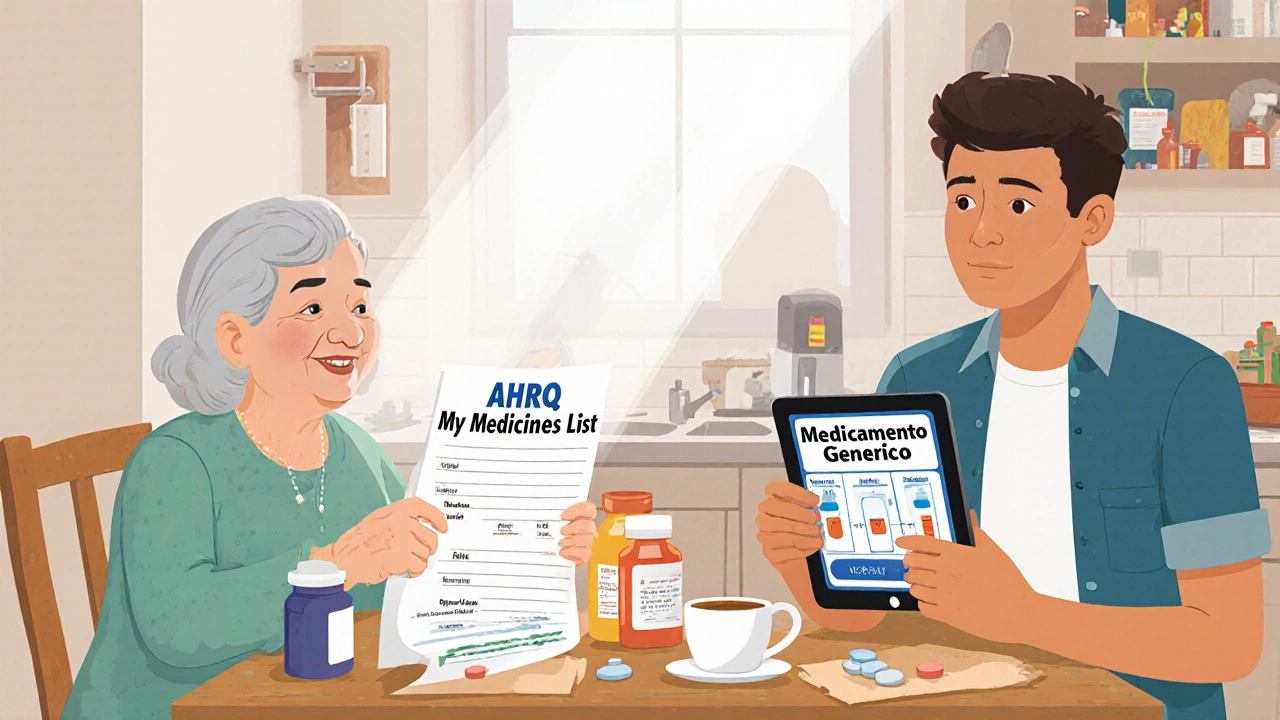
Regional Differences That Can Hurt
Here’s a real problem: the same drug has different names depending on where you’re from. In Spain, you’ll hear "paracetamol". In Mexico or the U.S., it’s "acetaminofén". They’re the same pill. But if a patient from Mexico moves to Texas and hears a doctor say "paracetamol," they might think it’s a new medicine. That’s not just confusing - it’s dangerous.
Most U.S. health systems use "neutral Spanish" - a version that avoids regional slang. But even that doesn’t solve everything. A 2023 American Hospital Association survey found that 68% of clinics use neutral Spanish, but only 28% explain that regional names mean the same thing. Patients are left guessing.
What Patients Are Really Saying
On Reddit’s r/MedicalSpanish forum, one user wrote: "Mi abuela dejó de tomar su medicina porque el farmacéutico le dio una pastilla diferente y no le explicó que era lo mismo. Ella pensó que ya no la ayudaría." (My grandmother stopped taking her medicine because the pharmacist gave her a different pill and didn’t explain it was the same. She thought it wouldn’t help anymore.)
A nurse in California shared: "I’ve had patients cry because they think switching to generic means they’re getting second-rate care. We need better tools to show them it’s not true."
Meanwhile, a 2023 California Health Care Foundation survey of 1,200 Spanish-speaking patients found:
- 78% felt more confident using generics after seeing bilingual guides
- 63% still believed brand-name drugs worked better
- 54% had been given a generic without any explanation
The gap isn’t in translation - it’s in trust.
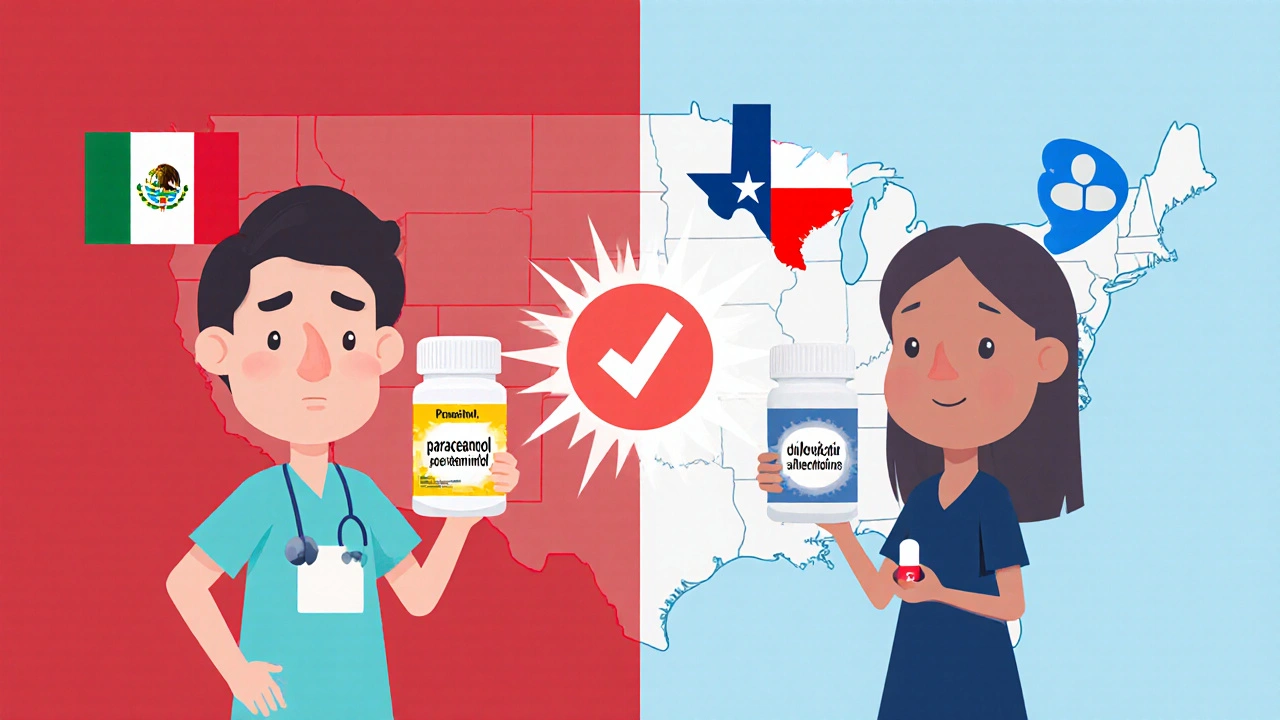
How Providers Can Do Better
Doctors and pharmacists don’t need to be fluent in Spanish. But they do need to use the right tools - and use them correctly.
- Always show the patient the pill - brand and generic side by side.
- Use the phrase: "Es lo mismo, solo cambió el nombre y el color." (It’s the same, only the name and color changed.)
- Point to the active ingredient on the label - it’s the same on both.
- Offer to call a translator if the patient is unsure.
- Never assume the patient understands because they nodded.
Some clinics, like Kaiser Permanente, now include QR codes on Spanish medication sheets that link to short videos explaining generic equivalence in different Spanish dialects. Since launching this in 2022, patient calls about pill appearance dropped by 52%.
The Bigger Picture: Why This Matters
There are 62.1 million Spanish speakers in the U.S. - over 18% of the population. That’s more than the entire population of Canada. And yet, only 41% of community health centers have full Spanish-language medication resources. Only 28% specifically explain generic equivalence.
Generic drugs save patients an average of $200 a month. That’s rent. That’s food. That’s transportation to appointments. But if patients don’t trust them, they don’t take them. And that leads to hospital visits, complications, and higher costs for everyone.
Health equity isn’t just about access. It’s about understanding. You can give someone a medicine. But if they don’t know what it is, or why it’s cheaper, you haven’t helped them.
What You Can Do Right Now
If you’re a Spanish speaker:
- Ask: "¿Es la misma medicina, aunque se vea diferente?" (Is it the same medicine, even though it looks different?)
- Check the active ingredient on the label. If it matches your old pill, it’s safe.
- Download the NIH "Medicamento Genérico" app. It’s free and works offline.
If you’re a provider or caregiver:
- Print out AHRQ’s Spanish "My Medicines List" and fill it out with your patient.
- Use MedlinePlus’s visual guides - they’re free and easy to share.
- Don’t just hand over a prescription. Explain it. Show it. Confirm they understand.
Generic medications aren’t second choice. They’re smart choice. But only if patients know it.
What does "medicamento genérico" mean in English?
"Medicamento genérico" means "generic medication" in English. It’s the same drug as the brand-name version, just sold under its chemical name instead of a brand name. It works the same way, has the same active ingredient, and meets the same safety standards - but costs much less.
Are generic medications as safe as brand-name ones?
Yes. The U.S. Food and Drug Administration (FDA) requires generic drugs to have the same active ingredient, strength, dosage, and effectiveness as the brand-name version. They must also be manufactured under the same strict quality controls. The only differences are in color, shape, or inactive ingredients - none of which affect how the medicine works in your body.
Why do generic pills look different?
Generic pills look different because U.S. law requires them to have a different appearance than the brand-name version. This prevents confusion and trademark issues. But the difference is only in color, shape, or size - not in the medicine inside. The active ingredient is identical. Visual guides showing side-by-side comparisons help patients understand this.
What should I say if my pharmacist gives me a different pill?
Ask: "¿Es la misma medicina, aunque se vea diferente?" (Is it the same medicine, even though it looks different?) Then check the active ingredient on the label. If it matches what you were taking before, it’s safe. You can also ask for a printed comparison sheet or use the NIH "Medicamento Genérico" app to verify.
Do Spanish-speaking countries use the same generic names?
No. For example, "acetaminofén" in Latin America is called "paracetamol" in Spain. Both are the same drug. This can cause confusion if patients move between regions or get prescriptions from different countries. Reliable resources now include notes about these regional differences to prevent mistakes.
How can I help a Spanish-speaking family member understand their medications?
Use AHRQ’s "My Medicines List" in Spanish to write down each medicine’s brand name, generic name, reason for use, dose, and schedule. Show them side-by-side photos of the pills. Watch a short video together from MedlinePlus or the NIH app. Ask them to repeat back what they understand. Don’t assume they know - even if they nod.
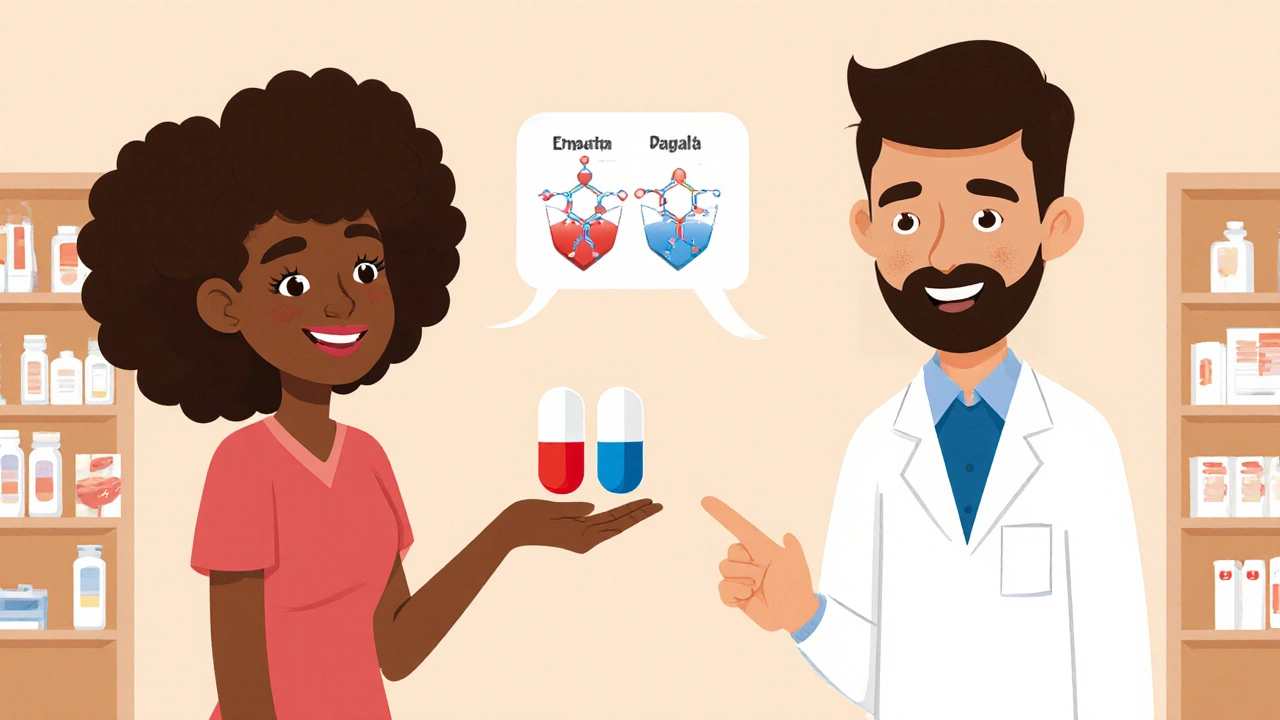
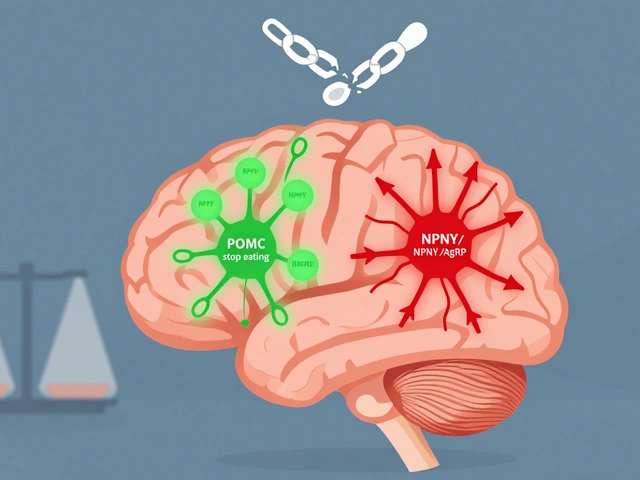
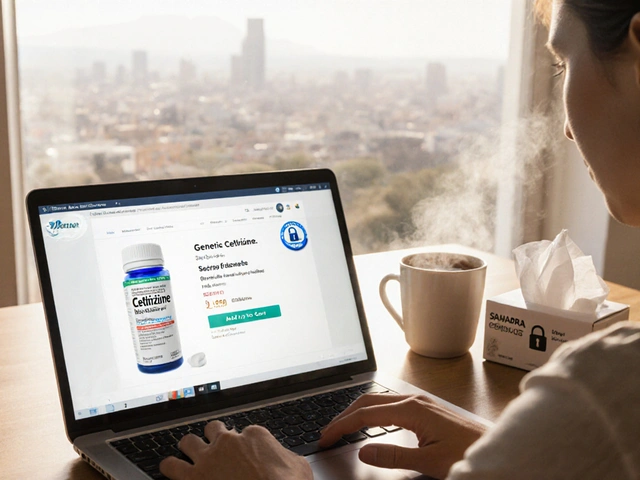
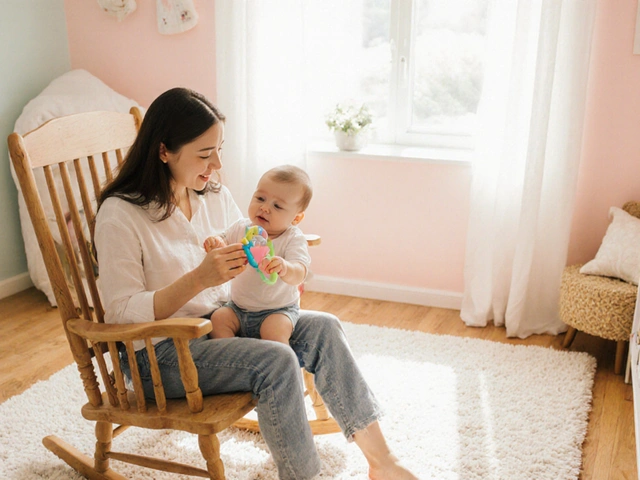



Just saw this and had to say - my abuela used to refuse her blood pressure meds because the pills were blue instead of purple. We found the NIH app together last year. She still uses it. Now she tells the pharmacist, "Mira, es lo mismo". Small wins, y’all.
Let me tell you something - in India, we don’t even have brand vs generic drama. We just call it "sasta dawa" - cheap medicine. And guess what? It works. Same molecule. Same results. The real issue isn’t language - it’s trust. And trust comes from seeing the same active ingredient on the bottle. No fluff. No marketing. Just science.
It’s not merely a linguistic dissonance - it’s an epistemological rupture in the very fabric of pharmaceutical equity. The symbolic capital of the brand-name pill - its chromatic aura, its ergonomic contours - has been fetishized into a metaphysical guarantor of efficacy, while the generic, despite its ontological equivalence, is relegated to the ontic margins of suspicion. We have, in essence, weaponized aesthetics against pharmacological truth. The FDA’s regulatory rigor is rendered meaningless when a patient’s phenomenological experience is dominated by the visual dissonance of a blue tablet versus a red one. The solution? Not translation. Not even education. We must dismantle the semiotic hierarchy that privileges branding over bioequivalence - and replace it with a phenomenological pedagogy grounded in visual parity. The pill is not its color. The pill is its molecule. And until we can make that visceral - until patients can *feel* the equivalence - we are merely rearranging deck chairs on the Titanic of healthcare disparity.
Actually, the term "neutral Spanish" is a linguistic fallacy. There is no such thing as a universally intelligible Spanish dialect - only politically convenient approximations. The AHRQ materials, while well-intentioned, still use Castilian syntax and vocabulary that alienate Central American and Caribbean speakers. For example, "pastilla" is common in Mexico, but in Puerto Rico, they say "comprimido." The NIH app’s pronunciation guide doesn’t account for Caribbean vowel reduction or Andean consonant softening. Until resources are co-created with regional linguistic communities - not just translated by contractors - we’re perpetuating a new form of linguistic colonialism.
Same pill. Different color. Ask. Check. Understand.
This hit home. 😔 My tío stopped his diabetes meds because the generic looked "too small." We showed him the NIH app, scanned his pill, and he just stared at the screen for a full minute… then said, "Ah, entonces es lo mismo." I cried. We need these tools everywhere - ERs, clinics, even corner pharmacies. 🙏 #GenericIsGood
One thing I’ve learned in my 12 years as a pharmacist: patients don’t need jargon. They need to see it. Hold the brand pill. Hold the generic. Point to the active ingredient. Say it out loud. Then ask them to repeat it. If they can say "acetaminofén" or "losartán," they’re not lost. Don’t hand them a pamphlet. Hand them a conversation.
From a pharmacoeconomic standpoint, the 85% cost differential isn’t just a savings metric - it’s a critical adherence multiplier. Non-adherence to antihypertensives and statins due to perceived inferiority of generics contributes to an estimated $100B+ in avoidable healthcare expenditures annually in the U.S. alone. The cognitive dissonance between perceived quality and actual bioequivalence represents a failure in health literacy infrastructure, not patient ignorance. The solution requires system-level intervention: mandatory visual aids in Rx workflows, standardized patient-facing pill comparison cards, and integration of the NIH app into EHR patient portals. This isn’t charity. It’s ROI.
Love this post. Just wish more pharmacies had QR codes like Kaiser. I showed my mom the video on the app last week - she said, "Entonces no es una estafa?" I told her no, it’s justice. 🤝
Wow. So we’re making a whole article about people not knowing what "genérico" means? Bro. It’s a pharmacy. They’re handed a pill. If they don’t know what it is, they should’ve learned English. Or asked. Or Googled. This isn’t rocket science. Stop treating patients like children.
Look. The real problem isn’t the pill. It’s the fact that we let corporations turn medicine into a branding contest. Brand-name drugs cost $200 because they paid for a 30-second Super Bowl ad. Generic? $12. Same molecule. Same science. But we’ve convinced people that a red pill is more powerful than a blue one. That’s not ignorance - that’s capitalism. And it’s killing people.
Had a similar thing with my mate from Chile. He thought his new generic statin was "weaker" because it was white. We pulled up the MedlinePlus side-by-side pic. He laughed. Said, "Oh. So it’s just the paint that changed." Simple. But so many don’t get it.
My sister works in a clinic in Arizona. She uses the AHRQ list with every Spanish-speaking patient. Says it cuts down on calls by half. Seriously, just print it out. Hand it to them. Fill it out together. It’s that easy.
Thank you for writing this. I’m a pharmacy tech in New Mexico. We’ve started showing patients the pills side by side. One woman cried and said, "I’ve been scared to take these for two years." We didn’t fix the system - but we fixed her fear. That’s enough for today.